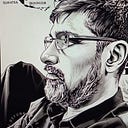Book Review: Anxious People
I read a little. Then a little. I did not buy the book, but I swear to buy the next one by Frederik Backman — he is witty and wise.
I can sense his writing. He picks ordinary people and places them in everyday situations. But under the simple construct, he applies a dose of comedy and simple-life philosophy that translates the story into a sweet yet solid plot.
I picked up Anxious People from my book group called ‘Travel Exchange’, and held on to it as I had to clear my TBR list. I did not look too much into the book — but I also got to understand that my favorite star Tom Hanks starred in a movie adaptation of ‘A man called Ove’ and realized his pattern. I admit that I am yet to lay my hands on that book. But I promise, I will.
Now back to the book, Anxious People.
A turquoise wrapper on a staid paperback. That explained the book in a sense. On both sides of the cover, the caricatures of the ten-odd characters appear to catch the reader’s interest. I fell back to these caricatures to feel the visuals.
A bridge. A suicide. A bank robbery. A hostage situation. Hostages, a bank robber, cops. That is all that the plot makes.
The story unravels with small truth bombs and time travel — a series of flashbacks and flashforwards. The author uses it to create a POV and then dismantles it as the story develops, thereby using the wrap-unwrap technique to create the plot twist.
The storytelling has three approaches — straight narration, cop interviews, and backstories. Placing them in a way that the story moves forward, Frederik uses the first half to unravel the characters in the beginning. He also revises the core point of the narrative — first, it is about the robber, then the hostage situation and then, a bridge, and finally the characters, who he often calls idiots.
There are those ‘Stockholmers’ who are irritating intruders in the small towner’s lives. But there are also characters who appear in the backstories that influence the characters strongly — the wife of Jim and the father of Jack, the ‘eternally infatuated’ Knut, the husband of Estelle, Ro’s father who knows everything, Julia’s mother who guides her to be kind and the ‘monkey and the frog’ children of the ‘elk’ — the bank robber turned hostage taker. They form key parts of the backstories.
Of course, there is the bridge that forms the ‘bridge’ — the connecting point of various characters — Jack and Nadia ( the psychologists who Zara visits).
Each character is quirky by itself and awkward when interacting with others. This quirky nature and awkward interactions make the story funny, but under that comical layer, the backstories evolve into the present — the hostage situation.
The cracks in each character get amplified and come to a head — relationships are tested like the one between Julia and Ro or the one between Roger and Anna-Lena. New relationships are formed like the one between Zara, the bank owner, and Lennart, the naked-rabbit disruptor. These odd relationships are the result of finding relatable and common ground through interactions and conversations.
Zara’s interaction with Nadia, and Jack’s relationship with Jim are traced as longer backstories, giving the reader a deeper understanding of how strangers begin to understand and how a father-son duo survives an ordeal but finds their bridge through their wife and mother.
The core of this story however is the discovery of common sense, empathy, and love between the characters, who finally decide to help the bank robber escape — and this includes the father-son cop duo. There is no villain, after all. Everybody yearns for love and wants to be connected. But in that effort, arise the errors and misunderstandings. So, ordinary people, much like us, are idiots.
As Backman writes :
“This story is about a lot of things, but mostly about idiots. So it needs saying from the outset that it’s always very easy to declare that other people are idiots, but only if you forget how idiotically difficult being human is.”
Finally, we all connect with each other in some way, but we don’t know that yet. We just are happy to start, plow through, and end the day somehow. But there is another part of us who want to be connected and loved. Between these two, our lives go on.
“We’re trying to be grown-up and love each other and understand how the hell you’re supposed to insert USB leads. We’re looking for something to cling on to, something to fight for, something to look forward to. We’re doing all we can to teach our children how to swim. We have all of this in common, yet most of us remain strangers, we never know what we do to each other, how your life is affected by mine.
Perhaps we hurried past each other in a crowd today, and neither of us noticed, and the fibers of your coat brushed against mine for single moment and then we were gone. I don’t know who you are.
But when you get home this evening, when this day is over and the night takes us, allow yourself a deep breath. Because we made it through this day as well.
There’ll be another one along tomorrow.”
I would recommend this book to all readers — it is a light yet profound read and belongs to the library.
~Ashok Subramanian © 2023
